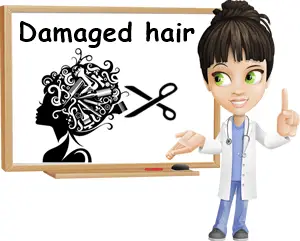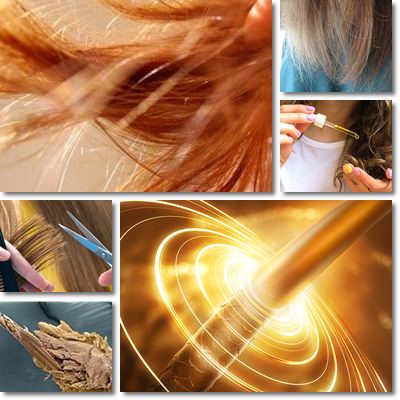Curly or straight or anything in between, thick or thin, fragile or strong, our hair is something we all take great pride in, whether we bother to style it or not. But oftentimes its appearance is not the picture of perfect health and we end up growing desperate to get rid of split ends, flat, lifeless, dry and overall damaged hair.
In order to be successful in our endeavor to bring our hair to its former glory it is important that we understand how it got that way and then work out the best remedy for us.
In more ways than one, the appearance of our hair is our own doing. It’s not enough to avoid styling our hair for it to be healthy, although it is true we can enjoy beautiful hair with minimum effort and almost zero costs.
The trick is to make smart, informed choices concerning the hair care products we use and understand that our hair requires two types of nutrition: external and internal. Our dietary habits and overall lifestyle are just as important for repairing damaged hair.

What does damaged hair mean?
Dry, dull hair, split ends, easy breakage are all synonymous with damaged hair because healthy hair is not supposed to be dry, dull-looking, split at the ends or break easily, even under the gentle pressure of a hair brush.
Hair damage generally occurs at the level of the hair shaft, or the visible part of our hair, the one emerging from the scalp. Most commonly, breakage occurs towards the ends but if damage is severe, the hair may break anywhere along its length.
Read below and find out what are the most common 8 causes that contribute to damaged hair.
What causes hair damage? ( 8 causes)
1) Mechanical damage
Using the wrong type of hairbrush, not changing it when its bristles wear off and split, brushing hair too often and too aggressively, especially when wet or pulling at it when tangled can, in time, lead to serious damage.
2) Heat damage
Flat ironing our hair daily or multiple times a day, even when using heat protectant products, curling it too often, using a rotating hair brush too often or even hair dryers can result in extensive hair damage very fast.
3) Improper use or overuse of hair care products
Using the wrong shampoo for our hair scalp type can prove just as damaging as washing our hair too often. Another damaging habit is overuse of hair care products altogether. As you may have noticed, shampoos and other hair care products contain chemicals such as sodium chloride or sulfates. While limited use does provide some benefits, extensive use can stress out our scalp and damage the hair shaft.

4) Not using conditioner
We might rarely need a nourishing hair mask if we remembered to always use conditioner, again, following recommended guidelines from producers. Conditioners exert a protective action on our hair, helping it retain moisture and some even providing the nutrients it needs to repair and rebuild itself.
5) Salt water and chlorine
The main reason why salt water and chlorine damage our hair is because they are aggressive towards our scalp, disrupting a fragile balance and directly impacting the quality of our hair.
Moreover, both salt and chlorine water damage our hair´s ability to properly retain moisture, causing it to dry out and become more prone to damage.
6) Friction
Tying our hair in a ponytail, low bun or any other similar, tight and stressful hairstyles can cause friction and subsequent damage. Friction can occur during sleep as well, but damage can be reduced if we use a satin or silk pillowcase.
In addition to allowing our hair to somewhat glide off, this type of materials do not retain moisture like cotton does and thus help preserve our hair´s natural moisture levels.
7) Chemicals
Dyeing our hair, relaxing or straightening it using chemicals, having a perm, bleaching our hair can all have devastating effects on its appearance. Not giving it sufficient time to recover from such harsh procedures can worsen damage beyond repair and require an urgent and substantial trim.
8) Not drinking enough water and not eating right
A healthy hair needs plenty of water to draw its moisture from and plenty of protein-rich foods to help it maintain a healthy structure. Having sufficient healthy fats in our diet also contributes to beautiful hair because fats offer protection and nourish hair.
Nutrition for hair
Our hair requires two types of nourishment: external and internal. And the nutrients it needs most are protein and healthy fats. Proteins are needed to help maintain hair structure and the reason for this is that our hair is almost entirely made out of protein.
Making sure we have enough quality protein-rich foods in our diet is a great way to enjoy strong, healthy hair and encourage damage repair. But more important, using shampoo, conditioner and hair mask brands with added protein for hair care can produce quite visible results as far as damage repair is concerned.
After all, our hair is made of protein, so why not supply it with what it needs?
Healthy, unrefined fats are a second macronutrient we can benefit immensely from, as long as we consume them in moderate amounts, as part of a balanced diet.
Eating foods rich in Omega-3 such as salmon, tuna, sardines, eggs, extravirgin olive oil, walnuts, foods rich in other types of healthy fats such as all kinds of nuts and seeds is a great way to increase our intake.
Aside from beautiful hair, skin and nails, with a particular glow to them, healthy fats hold benefits such as cholesterol control, reduced cardiovascular disease risks, improved thyroid hormone function, improved brain function and mood etc.
Healthy fats are particularly efficient when applied directly on the scalp, at the roots and along the length of the hair. Essential and carrier oils such as olive oil, argan oil, macadamia oil, almond oil, avocado oil, perilla seed oil, jojoba oil, rose hip seed oil etc. are particularly nourishing, not to mention all-natural.
They can be applied in trace amounts on the scalp and along the length of the hair and let to sit at least 20 minutes, after which we can proceed with our normal washing routine. Best results are seen when the oils are applied 2-3 times a week on damaged hair, preferably before washing it.
What to do to prevent hair damage?
Here are 11 Useful Tips on how to prevent and reduce hair damage:
1) Apply an oil mask to the hair half an hour prior to washing it, at least once a week.
2) Use a protein-based conditioner once or twice a week or protein-based hair treatments.
3) Avoid brushing or combing hair while wet.
4) Use wide tooth combs or hairbrushes with soft bristles to minimize damage.
5) Reduce heat manipulation by using hair dryers, rotating hair brushes etc. less often.
6) Minimize damage by choosing looser hairstyles that do not pull on the scalp.
7) Avoid tying your hair, wearing tight caps or playing with it.
8) Trim ends regularly to prevent them from splitting.
9) If damage is extensive, opt for a layered haircut.
This will help get rid of much of the damaged hair and look more put together without much manipulation.
10) Use semi permanent hair dyes and give your hair time to recover in between procedures.
11) Sleep on silk or satin pillowcases and avoid washing hair daily.
